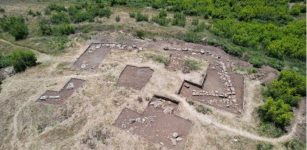Maize-Based Diet Of Ancient Maya, Vulnerability To Drought And Collapse Of Society
Conny Waters - AncientPages.com - Researchers analyzed the role of diet in the ability of the ancient Maya to withstand periods of severe climatic stress.
An increase in the elite Maya's preference for a maize-based diet may have made the population more vulnerable to drought, contributing to its societal collapse, they said.
"Population expansion and anthropogenic environment degradation from agricultural intensification, coupled with socially conditioned food preferences, resulted in a less flexible and less resilient system," study co-author Claire Ebert, wrote.
"Understanding the factors promoting resilience in the past can help mitigate the potential for similar sudden and dramatic shifts in our increasingly interconnected modern world."
In the study, researchers used the remains of 50 human burials from the ancient Maya community of Cahal Pech, Belize, dated between 735-400 BC and as late as the Terminal Classic, approx. 800-850 AD.
For the burials dating to the Preclassic and Early Classic periods, representing the early inhabitants of the Cahal Pech, Ebert's results suggest that both elites and commoners had a diverse diet that, in addition to maize, included wild plants and animals procured through hunting. Ebert suggests that this diversity of food provided a buffer when a multi-century drought impacted the May lowlands between 300-100 B.C.
During the Terminal Classic period, between 750 and 900 A.D., growing social hierarchies and population expansion led to the intensifying of agricultural production and increasing reliance on maize. During this time frame, humans from surrounding settlements at Cahal Pech had different carbon values than the site's center, where the elite class lived.
"Our results show a pattern of highly restricted stable nitrogen and carbon isotopes for elite individuals in the Late and Terminal Classic, which corresponds to a hyper-specialized maize-based diet that persisted through the final abandonment of the site," Ebert wrote.
Elite demands on the local population for increased maize production, and a preference for this drought-intolerant crop, was likely a factor that contributed to the failure of the Cahal Pech socio-political system in the face of another severe drought at the end of the Terminal Classic Period.
The study speaks to the importance of diet in the resilience and decline of ancient societies and contributes to our understanding of vulnerability to climate change among modern traditional farming communities as well as industrialized nations, according to Ebert.
Written by Conny Waters - AncientPages.com Staff Writer





















